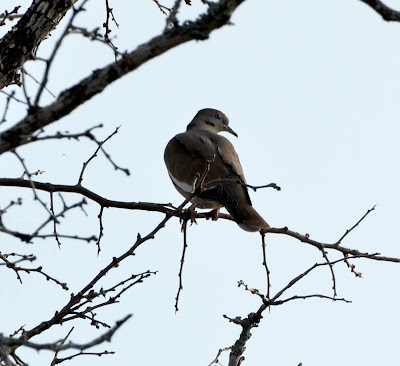Friday, February 22, 2013
Hardberger Park, Oak Loop Trail
Today's photos:
I arrived at Hardberger Park fairly late in the afternoon. As so often happens at this time of the day, the quality of the light helped set the mood. The woods acquire something of a magical aura as the sun lowers towards the horizon.
- The first two photos are an American Crow. The distinctive "caw, caw, caw" the crow cried out attracted my attention before I actually saw the bird emerge from above the woods.
- The third and fourth photos are a White-winged Dove that was keeping close watch over the trail.
- The fifth photo is an Agarita shrub in full bloom. The agarita were the only flowers I saw blooming along the trail.
- The sixth photo is a Christmas Cactus also known as the Christmas cholla and tasajillo. Along with the numerous prickly pear clusters, the Christmas cactus grows in abundance in this area of the park.
- The seventh and eighth photos are Live Oak trees from which the Oak Loop Trail gets its name. The woods in this area is dominated by the live oaks. There are also some Ashe Juniper growing in the area. As can be seen in the eighth photo, the Texas Persimmon provides much of the lower understory growth, As a matter of fact, there is so much Texas persimmon growing along the trail, this could just as well be called the "Persimmon Loop Trail," but I guess that doesn't quite have the same appeal to it.
- The ninth photo is a close up of a Texas Persimmon trunk with its distinctive smooth bark.
- The tenth photo is a family of White-tailed Deer that were walking along the tree line along the edge of the recently cleared savannah restoration area. The PVC pipes are the irrigation system for the restoration project. This spring the newly planted prairie grasses will grow tall enough to hide the irrigation system from view.
- The eleventh, twelfth and thirteenth photos are a Turkey Vulture soaring through the evening sky above the savannah restoration area.
- The moon is the most obvious object in the fourteenth photo. Somewhat less obvious, but equally important, are the thin, wispy cirrus clouds being blown along in the jet stream high overhead.
- The fifteenth photo is another close up of a Texas Persimmon.
Thursday, February 21, 2013
This set of photos of a Snowy Egret was taken on my walk along the Museum Reach of the San Antonio River on Monday, February 11, 2013. This was the same walk where I took the photos of the little blue heron that I posted the following day.
Both the snowy egret and the little blue heron landed on opposite banks of the River just below a riffle. Food supplies are generally more abundant in and immediately below the riffles because of the increased oxygenation levels in the water at these locations.
It is also worth noting that these two birds stayed on opposite sides of the River because the egrets and the herons are very territorial. They generally maintain a safe distance from each other to avoid a conflict.
Wednesday, February 20, 2013
Brackenridge Park, from Mulberry Ave upstream
along the bank of the San Antonio River and back south
along the western half of the Wilderness Loop Trail
Today's photos:
The sky was completely overcast with fairly dense clouds, but the mood on my walk was definitely not "grey." Birds were very active. Trees are budding out. Flowers are blooming. Insects are appearing. Even though there wasn't any direct sunlight, the turtles were out on logs in the river.
The lighting was perfect. I almost always prefer doing nature photography with the diffuse light of a cloudy sky. I couldn't have asked for much more. (Well, a good soaking rain would be welcome now, but that is a topic for another day.)
It really was an amazing experience and these are only a few highlights from the multitude of photographs I took:
- The first photo is a female Northern Cardinal.
- The second, third and fourth photos are a male Northern Cardinal.
- The fifth and sixth photo are a male Mallard.
- The seventh photo is a point bar that has formed, as they typically do, on the inside of a curve in the River. The branch that had fallen on the gravel provided a perfect visual accent in the photograph to complement the vegetation beginning to grow at the downstream end of the bar.
- The eighth and ninth photos are Baby Blue Eyes. These flowers are blooming profusely along the Wilderness Loop Trail.
- The tenth photo is a Cedar Elm tree beginning to set its leaves. Compared to the other cedar elm in the park, this one tree was apparently ahead of schedule.
- The eleventh photo is a False Dayflower also known as Widows Tears. These flowers are also beginning to bloom in abundance.
- The twelfth photo is a Red-eared Slider turtle. This is one of the largest red-eared sliders I have seen.
Tuesday, February 19, 2013
But wait. There wasn't just one Greater Roadrunner out in the savannah at Stone Oak Park. There was actually a pair of roadrunners. Male and female roadrunners have a very similar appearance. Females are a bit smaller and lighter in color than the males. These birds, like most, are monogamous, so it was not surprising to see a pair of them together:

























































